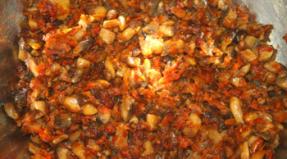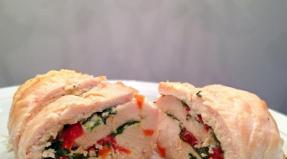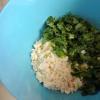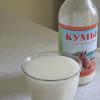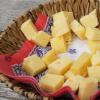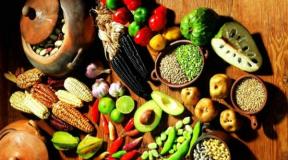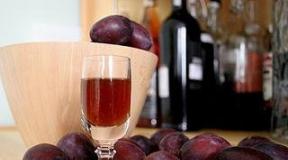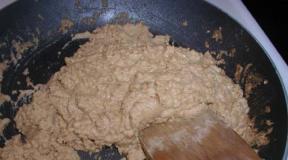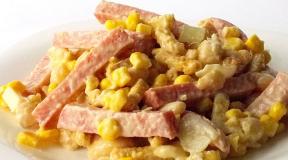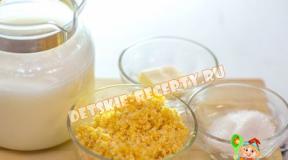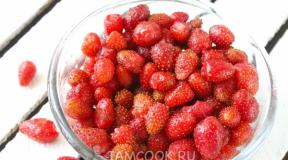How to process harvested mushrooms in the forest. Processing and storage of mushrooms
Mushrooms belong to perishable products, they cannot be stored long time. Therefore, these gifts of the forest must be processed on the day of collection.
Mushrooms are cleaned of debris, legs are cut off, damaged areas are cut out. To prevent the mushrooms from turning black, stainless steel knives are used for these purposes.
The main ways to preserve mushroom gifts are: drying, salting, pickling and canning by sterilization in hermetically sealed glass jars.
Mushroom harvesting
Food products of plant and animal origin due to the presence in them of significant amounts of moisture, protein compounds, carbohydrates and other soluble nutrients during storage, they are quickly exposed to various enzymes and microbes and become unusable. Therefore, people have long been looking for ways to preserve various products for a long time.
The existing methods of storing mushrooms and other products are based on creating conditions for microbes under which they cannot develop, and products subjected to canning do not lose their inherent properties. fresh nutritional and taste qualities and can be stored for a long time without spoiling.
The main methods of preservation are: drying, salting, marinating and canning by sterilization in glass jars sealed hermetically. Many microbes and bacteria are detrimental to heating. Some of them die at a temperature of 60 °, others - at 60-100 °. However, spores of some bacteria can tolerate temperatures of 100-110 and even 120 ° and remain viable.
Later, under normal temperature conditions, they begin to develop and multiply .. Especially dangerous in canned food botulinum bacteria. They produce a potent poison that causes human poisoning, sometimes even fatal. Due to the fact that botulinus is found in the soil, when harvesting products for the future, they must be very carefully washed, cleaned, and damaged and stale fruits should not be used.
It has been established that when products are stored in an acidic environment (acetic or citric acid), botulinum does not develop. Therefore, canning food products with the use of acetic and citric acids is used quite often.
The main methods of processing and storing mushrooms:
Drying mushrooms
mushroom powder
mushroom extract
Freezing
Salting
Pickling
Preservation in hermetically sealed containers
Drying mushrooms
Drying is one of the most affordable and simple ways mushroom processing. Without much reduction in their taste and nutritional qualities dried mushrooms persist for quite a long time.
From marsupials: - white truffle, morel cap, morels.
From tinder fungi: - branched and variegated tinder fungus and ram mushroom.
From lamellar: - summer, autumn and winter, variegated umbrella mushroom, champignon, fenugreek, fleecy flake, deer mushroom, etc.
Mushrooms with a bitter taste are not suitable for drying (all types of milk mushrooms, lactifers, valui, volnushki), since bitterness does not disappear during the drying process.
For drying, fresh, strong, not worm mushrooms. They are cleaned of forest debris and wiped with a slightly damp cloth. It is not recommended to crush mushrooms before drying. In large specimens, the hat is cut off from the stem. If the skin is removed from the cap, then it is better to remove it.
Small mushrooms are dried whole, large ones are cut into pieces. To avoid contamination, the mushrooms are dried on special devices: lattices, sieves strung on a thread or knitting needles. Mushrooms are dried in the sun and in the oven. In the air, mushrooms can be dried only in hot and dry times, on clear sunny days. In cloudy weather, drying mushrooms on outdoors not recommended - they can go bad.
In any case, the mushrooms are first dried at a temperature of 40–50°C for 2–4 hours, and then, increasing the temperature to 60–70°C, they are dried for 8–12 hours. Dried mushrooms are very hygroscopic, that is, they have the ability to absorb moisture from the air, so dried mushrooms are stored in closed glass jars in rooms with a temperature of 8–10 ° C.
mushroom powder
From dried mushrooms you can get mushroom powder. Mushroom powder is prepared from those mushrooms that, when dry, have a strong mushroom aroma And pleasant taste.
For the preparation of mushroom powder, the following are used: porcini mushrooms, boletus, umbrella mushrooms, morels, mushrooms, chanterelles, truffles, boletus, boletus, winter mushroom and others. The powder is prepared both from one type of mushrooms and from several. Mushrooms are prepared for drying, and then dried as described above. For the manufacture of mushroom powder, dried mushrooms with a moisture content of not more than 12% are used. They are ground in a coffee grinder, pepper mill or ground in a porcelain or metal mortar.
The resulting powder is sifted through a fine sieve, the remaining large particles are dried and ground a little more, because the finer the mushroom powder particles, the better they are absorbed by the body.
Mushroom powder is even more hygroscopic than dried mushrooms, and if left uncovered, it will spoil quickly. Therefore, mushroom powder should be stored in tightly closed jars in a dry place.
Mushroom powder is used in cooking for cooking mushroom puree, as a seasoning for soups, borscht, sauces, meat, fish and vegetable dishes. Before using to mushroom powder add a small amount warm water, in which it swells for 20-30 minutes. Then this mass is added to the prepared dish and boiled for 10-15 minutes.
mushroom extract
Mushroom extract can be prepared at home from mushrooms. Mushrooms without a bitter taste are used for this, but it is better to take mushrooms with a strong mushroom aroma for these purposes, from cultivated ones these include: champignons, oyster mushrooms, mushrooms, from wild mushrooms, mushrooms, boletus, boletus and other mushrooms that have a pleasant taste and strong aroma.
Mushrooms are thoroughly cleaned and washed, then they are cut and passed through a meat grinder. The resulting mass is boiled for half an hour in own juice on low fire enamel saucepan. formed mushroom juice strain through gauze previously sterilized by boiling, and put the mushroom mass back into the pan, add a little water and boil again so that all the juice comes out, it is filtered in the same way as for the first time.
The resulting liquid is salted at the rate of 20 g of salt per 1 liter and boiled over low heat in a wide saucepan without a lid, allowing the water to evaporate. Boil until part of the water evaporates and the broth thickens like a syrup, which, in fact, is a mushroom extract.
The extract is poured hot into small sterilized bottles, tightly closed and quickly cooled. In this form, the mushroom extract can be stored in a cool place for 2-3 years.
Mushroom extract has a pleasant mushroom flavor and flavor and used as flavor additives to soups, meat and fish dishes, sauces, gravies. Before use, the extract is diluted with water.
Freezing
Recently, due to the emergence of large freezers it became possible to store the mushroom product in a frozen form. Although this method of storing mushrooms is more energy-intensive than canning, but with the right process, freezing allows you to save all the valuable nutritional components in the fruiting bodies.
For freezing, medium-sized young mushrooms are used that are not damaged by pests, do not contain bitterness and bad smell. They are thoroughly washed, changing the water several times. Then they are lightly dried. The quality of freezing is affected by the speed of freezing. It is best to freeze mushrooms at -30°C for 2–3 hours.
Frozen mushrooms are stored at a temperature of -18 ° C and an air humidity of 95%. At home, mushrooms are frozen in metal molds 5–6 cm high. For these purposes, tin boxes from under herring or plastic bags. One cold store other products cannot be stored with mushrooms, as mushrooms are able to absorb odors.
Defrost mushrooms just before cooking mushroom dish at a temperature of +20°C for 2-3 hours, which ensures the gradual melting of ice crystals in the cells of fungi. Thawed mushrooms are a favorable environment for various microorganisms, therefore, after thawing, mushrooms should be immediately used for cooking mushroom dishes.
Frozen mushrooms are stored at -18°C for up to a year. You can freeze boiled and fried mushrooms. Peeled and washed mushrooms are cut and boiled for 15-20 minutes (or until tender). Then the mushrooms are taken out of the broth, cooled, laid out in plastic bags and placed in the freezer. You can freeze fried and stewed mushrooms- they are stored no more than three months.
Salting
A very common method of harvesting mushrooms. Almost all types of mushrooms can be salted, but usually only agaric mushrooms with a sharp bitter taste are salted: milk mushrooms, valui, volnushki, mushrooms, russula, rowings, talkers.
Mushrooms High Quality, which have a specific taste and aroma (milk mushrooms, mushrooms), are salted separately, lower-grade mushrooms are mixed.
Mushrooms are salted in wooden barrels, glass and enameled containers with intact enamel. Containers for salting mushrooms should be very clean and free of foreign odors. It is impossible to use earthenware for salting mushrooms, since under the action of salts and acids it becomes unsuitable for further use.
In addition, the glaze covering earthenware may contain lead, which, when dissolved in brine, poisons mushrooms. It is also impossible to salt mushrooms in galvanized tin dishes.
There is a cold and hot way ambassadors.
The cold method is different in that mushrooms are not boiled before salting. Mushrooms are cleaned and washed. Volnushki, valui, milk mushrooms, bitters and other mushrooms with a pungent taste are soaked in lightly salted water for 1-3 days. Mushrooms that do not contain bitterness should not be soaked.
Salt is poured onto the bottom of the container, then a 6-8 cm layer of mushrooms, again salt and a layer of mushrooms, and so on until the container is filled. For 1 kg of mushrooms put 40-60 g of salt.
High-quality mushrooms are salted without any additives to preserve their specific taste and aroma. A little garlic is added to real milk mushrooms during salting. Sometimes, when salting, pepper, garlic, dill, blackcurrant leaves, cherries are added to mushrooms, Bay leaf. From above, salted mushrooms are pressed down with a wooden circle, on which oppression is placed. Bricks, lime stones and metal objects cannot be used as oppression. After a couple of days, the mushrooms release juice and settle.
The mushrooms are also salted in a dry way, in which the mushrooms are not washed. They are cleaned, wiped with a damp cloth and placed in a container, sprinkled with salt. It is claimed that dry-salted mushrooms are tastier and more aromatic.
Mushrooms become ready for use in a month and a half. Non-bitter types of russula and mushrooms can be used after 5-10 days.
Salted mushrooms are stored at low positive temperatures (not higher than + 6–8 ° С), making sure that they are covered with brine on top. If the brine disappears, add cold salty water (50 g of salt per 1 liter of water). The emerging mold is removed, the lid is washed in hot water and wipe the edges of the container with a clean cloth.
The hot salting method is used for salting mushrooms with a bitter taste: all types of milk mushrooms, milkers, valui, volushki.
Peeled and washed mushrooms are boiled in salted water for half an hour or blanched (dipped in boiling water for 5-15 minutes). Then they are thrown into a colander so that they dry a little. Then they fill the containers, pouring salt in layers, just as with the cold method. Hot-salted mushrooms can be eaten after 2-3 weeks.
Pickling
Mushrooms are usually marinated with better taste than those used for salting. When marinating champignons, mushrooms are selected, the caps of which do not exceed 15–35 cm in diameter. Mushrooms are cleaned, stems are cut, washed thoroughly cold water and, throwing it in a colander, let the water drain.
In order to pickle a kilogram of mushrooms, you will need a marinade prepared from 0.5 liters of water, 50–60 g of 30% acetic acid, 10–12 peppercorns, 2–3 bay leaves, 10 g salt; cinnamon, cloves and nutmeg add to taste. The marinade is prepared as follows: acetic acid is poured into the water, spices are added and brought to a boil.
Mushrooms are boiled for 5 minutes in lightly salted water, then they are taken out with a slotted spoon, allowing the water to drain. For a few more minutes, the mushrooms are boiled in the marinade, then transferred to prepared jars and immediately closed.
When marinating, mushrooms can be boiled immediately directly in the marinade. To pickle 1 kg of mushrooms, take 1/3 cup of water, 1 tablespoon of salt, 2/3 cup of 8% vinegar. The marinade is brought to a boil in an enamel pan, then washed and peeled mushrooms are placed in it.
The cooking time of mushrooms depends on their type: for example, for oyster mushrooms it is 30 minutes, for champignons - 20. The foam formed during cooking is removed with a slotted spoon, after the foam stops appearing, 1 teaspoon of sugar, 5–6 peas are added to the boiling marinade pepper, 2 bay leaves, 2 g cloves, a little cinnamon and citric acid(on the tip of a knife). After boiling, the mushrooms are transferred to jars, poured with marinade and closed.
Preservation in hermetically sealed containers
Currently for canning various products used at home glass jars with tin and glass lids. Tin lids they close the jars with the help of seamers, the glass lids are held with special tin clamps.
Mushrooms are placed in hot jars. Then, a pre-prepared hot (boiling) filling is poured into the jar. The degree of filling of the cans should be as high as possible so that as little air remains as possible. You can sterilize jars in a tank or pan, on the bottom of which a wooden grate is placed, metal grid or a piece of canvas folded 3-4 times (it is important that the jars do not touch the bottom and walls).
The poured water is heated to 50-60 °, then jars filled with mushrooms and covered with lids are placed there. The amount of water in the tank should be such that its level reaches the neck of the cans or is slightly lower.
After that, the water is brought to a boil and kept half liter jars 20-25, liter - 25 - 30 minutes from the moment the water boils. At the end of sterilization, the jars are removed, while making sure that the lids do not rise or move, and quickly cork with a seamer.
In the manufacture of marinades, jars are sealed before pasteurization (in order to prevent acetic acid from volatilizing). In such cases, there may be a breakdown of the lids during heating (due to a significant increase in pressure inside the jar). To avoid this, special steel clamps (screw or spring) are preliminarily put on the covers.
Closed jars must be completely immersed in water. Jars with glass lids are also sealed prior to sterilization. When sterilized, they are immersed in water with a lid. After sterilization is completed, the jars are cooled, and the clamps are removed (but you can not remove them).
0
fresh mushrooms collected in the forest or bought on the market, you need to quickly prepare for cooking. Only then will they retain their taste and be elastic and fragrant.
Dishes from properly peeled and chopped mushrooms are beautiful and appetizing.
The main rule is that mushroom cleaning should not be postponed for a long time. Cut mushrooms in a warm room deteriorate and quickly become flabby. They easily lose their unique forest spirit. After a hike in the forest, you need to get down to business as soon as possible.
If this is not possible, you can keep your prey until morning in a refrigerator or other cool place, for example, in a cellar.
What tool should I use to quickly clean?
 You will need a small sharp knife to do the job. A thin tip is convenient to remove spoiled places and clean out debris. The sharpened blade will easily cut the fragile flesh and will not crumble it.
You will need a small sharp knife to do the job. A thin tip is convenient to remove spoiled places and clean out debris. The sharpened blade will easily cut the fragile flesh and will not crumble it.
A damp cloth or paper towels can be used to wipe off dried-on dirt.
Mushroom juice contains substances that blacken the fingertips. Use gloves to protect your hands while working.
Prepare an empty container for clean mushrooms and water for washing.
Is it necessary to wash?
When washed, mushrooms absorb a lot of moisture and lose their taste. Therefore, it is better to limit yourself to dry cleaning, where possible. Mushrooms that you are going to dry for the winter should not be wetted in any case, they can only be wiped with a damp cloth. Before frying, it is also better to do without washing, but if necessary, you can quickly rinse with water.
- cooking;
- salting;
- pickling.
Mushrooms for pickling, which have a bitter taste, are soaked for one or two days in cold water, regularly replacing it with fresh water.
Preliminary processing
 The first stage of cleaning takes place in the forest. Large debris is removed from the found mushroom: twigs, leaves, needles. The root is cleaned with a knife from the earth and sand, or simply cut off to check if there are any worms inside.
The first stage of cleaning takes place in the forest. Large debris is removed from the found mushroom: twigs, leaves, needles. The root is cleaned with a knife from the earth and sand, or simply cut off to check if there are any worms inside.
Unfamiliar varieties should never be taken. Even one inedible mushroom in a basket can lead to poisoning.
Strongly wormy, moldy and very old specimens should also be left in the forest. They will spoil the taste of food and can be harmful to health.
Mushrooms bought in a store or on the market have already undergone primary cleaning. Only small debris or traces of soil remain on them. Such mushrooms at home should be sorted out again, cut off the damaged places and, if necessary, washed. After that, you can cook and eat them.
White
White mushrooms are not only the most delicious, they are also easy to clean. They usually grow in light and dry places or in moss. These noble beauties only cut the earth around the circumference of the root. It is enough to wipe the hat or fan it with a brush. Carefully cut off places spoiled by forest dwellers.
White ones, which are only slightly affected by worms, can be used for harvesting for the winter. During the drying process, the worms do not eat the mushroom from the inside, but crawl out.
boletus
Boletus mushrooms are often wormy, to check they immediately cut off the tip of the leg. In large specimens, for the same purpose, the hat is separated and cut in half. There may be worms at the bottom of the cap, even if the rest of the mushroom is not affected by them. Then the spongy layer is completely removed. The leg is cleaned with a knife, removing upper layer skins, although some mushroom pickers believe that this is not necessary.
In old boletus, the legs become hard and fibrous. In cooking, it is better not to use such parts at all.
The video shows how to properly clean boletus.
Aspen mushrooms
Aspen mushrooms are processed in the same way as boletus. The top layer is scraped off the legs. There is no need to remove the skin from the cap, just brush off the dirt with a cloth. The spongy bottom of the cap should be checked for the presence of worms and fungal mosquito larvae. Aspen mushrooms are distinguished by the fact that they turn blue and then blacken on the cut. To prevent this from happening, it is recommended to immediately throw the pieces into the water after cutting.
 cute mushrooms growing big families, and it is not easy to cope with a whole mountain of oil. Difficulties arise due to the slippery film that covers the oil heads.
cute mushrooms growing big families, and it is not easy to cope with a whole mountain of oil. Difficulties arise due to the slippery film that covers the oil heads.
At heat treatment she becomes rough and a little bitter. Hats must be cleaned. To prevent the film from sticking to the hands, the oils are dried. Another folk way- Pour boiling water over them.
You can oil your hands or wear gloves, otherwise the fingertips will darken from the sticky skin.
Otherwise, in young butterflies, they only trim the leg. In older ones, the leg can be slightly scraped and the remains of the collar under the hat can be removed.
Chanterelles
Red fragrant fungi are remarkable in that they contain a substance that repels worms. They do not need to remove the skin or separate any parts. For cleaning, only cut off the lower third of the legs with traces of soil. Chanterelles have a rather bizarre shape. Earth or needles get stuck between the plates, which are not easy to remove.
Fortunately, chanterelles can be washed in in large numbers water. To make them more elastic and not break, they are poured with boiling water. This simplifies subsequent processing.
 At large champignons skins are removed from the caps. This is done by a simple movement of the knife, from the edge to the center. In the caps of young mushrooms, the top layer can be left. If the legs of the champignons are harsh, they are cut shorter or removed altogether. The collar is edible and does not need to be peeled off.
At large champignons skins are removed from the caps. This is done by a simple movement of the knife, from the edge to the center. In the caps of young mushrooms, the top layer can be left. If the legs of the champignons are harsh, they are cut shorter or removed altogether. The collar is edible and does not need to be peeled off.
When washed, champignons strongly absorb water and lose their taste. Try to do dry processing and shake off all the debris with a cloth.
If it doesn’t work out, you can quickly rinse and discard the mushrooms in a colander.
oyster mushrooms
Oyster mushrooms are very easy to clean. They grow on tree trunks, so grass and needles practically do not stick to them. These mushrooms are good only at a young age; when sorting, old specimens are immediately removed and set aside. Those with a hat no more than 10 cm are selected for food. The bottom of the leg, damaged edges and dried places on the fruiting body are cut off. It is convenient to wash oyster mushrooms in a sieve under running water, but you can also soak them in a bowl.
Honey mushrooms
Honey mushrooms on long thin legs grow on stumps and practically do not get dirty. From them it is only necessary to collect leaves and needles and cut the tips of the legs. If the lower part of the leg is stiff, it is also cut off. The skin is not removed from the hat. However, rotten and darkened areas must be removed.
 It is believed that mushrooms are the purest mushrooms, but they still need to be processed. Adhering blades of grass, twigs and needles are brushed off with a brush or knife.
It is believed that mushrooms are the purest mushrooms, but they still need to be processed. Adhering blades of grass, twigs and needles are brushed off with a brush or knife.
Camelinas are often found on sandy soils, sand sticks to the roots and from the underside of the caps. Together with the rest of the foreign particles, it is easy to wash it off by briefly soaking the mushrooms in the basin. Gathering in the forest, they are not uprooted from the ground, but immediately cut off with a knife. If you brought them home whole, then the roots will have to be cut off.
Milk mushrooms
Milk mushrooms are first simply washed, cleaned of sand and other debris. Then they are soaked in cold water for three days to get rid of the bitter taste. The water needs to be changed several times a day. The container with mushrooms is placed in a cool place so that they do not sour. With a brush, knife or hard sponge, soaked milk mushrooms are scraped off to white color. Then finally wash and remove damaged areas.
 First of all, raincoats are washed, gently rubbing the dirt with fingertips. The soft shell-like outer layer separates from the pulp. In large mushrooms, this skin is conveniently removed with a knife. For control, spherical fruiting bodies are cut in half. If the flesh is white and elastic, you can eat it.
First of all, raincoats are washed, gently rubbing the dirt with fingertips. The soft shell-like outer layer separates from the pulp. In large mushrooms, this skin is conveniently removed with a knife. For control, spherical fruiting bodies are cut in half. If the flesh is white and elastic, you can eat it.
Raincoats with a yellowish center are best thrown away. They are either old or damaged. Puffballs are not poisonous, but a bad-tasting mushroom will spoil the dish.
After dry cleaning, mushrooms can be stored in the refrigerator for a short time, but after washing, they must be cooked immediately. For soup, hodgepodge or preparations (except for drying), you can boil them for future use with no big amount salt and use then within a few days.
To cooking masterpiece subsequently looked beautiful, the mushrooms are carefully cut into pieces of equal size. Fibrous legs are cut across, and caps into triangular segments. Small mushrooms can be eaten whole, they look especially beautiful in jars with marinade. The goal of neat and correct processing- save valuable qualities mushrooms to fully develop them in the preparation of delicious dishes.
Just like some types of mushrooms, boletus are the owners of a speaking name. What does it mean? The fact that the name of the mushroom says where it grows, where, accordingly, it is worth looking for and collecting, and also what is a 100% guideline that guarantees the presence of a truly rich mushroom place. For example, a boletus is a mushroom growing in a forest, a boletus is near an aspen, and the boletus discussed in our case are rich birch groves. And what to do with boletus after collection, this article will tell you.
When going in search of these forest beauties, you should pay attention to shady places near the trees. Nevertheless, it is not for nothing that these gifts of the forest received such a name. As practice proves, in most cases it is simply impossible to find an impressive mushroom catch in sunny glades and open areas.
In groves or deciduous forests, these mushrooms can be found in several types:
- ordinary;
- multi-colored;
- ash gray;
- blackening (chess);
- white (marsh);
- black.
All fruits, in addition to the color of the hats, which is already becoming clear by the name of each species, also differ in the place of growth. Despite this, the method of cleaning and pre-preparation of the collected fruits for further manipulations is the same for all varieties.
Collected fresh boletus should be carefully removed from the basket or basket and laid out on a wide horizontal surface, after covering it with newspaper, oilcloth or a piece of dry cloth. Immediately after the harvest, even before you start processing the forest harvest, you should:
- carefully inspect all the decomposed boletus mushrooms;
- clean the hats from adhering cobwebs, foliage, forest debris and other contaminants;
- process the legs of the boletus, carefully removing the remnants of soil, dirt, foliage and the rest of the mycelium with a knife;
- it will be right to once again inspect all the mushrooms and assess the degree of damage and the presence of putrefactive formations.
What to do if the mushrooms turned out to be wormy
Carefully examining the fruits, you need to make sure that they are not wormy. To do this, it is enough to either cut the mushroom, or simply break it. It is very important to check for damage to both the cap and the legs of the boletus. Fully wormy mushrooms should not be exposed further processing and especially cooking. The best solution in such a situation would be to get rid of them.
How to wash
Competent processing of boletus includes the second stage. Now you need to properly wash the boletus in plain water. What are the recommendations for this? Use the following proven tips:
- it is best to use running water (ordinary from the tap) at a cool temperature;
- in the process of washing, additional cleaning of the boletus is also carried out, where with the help of a small knife, a culinary scraper or a hard foam rubber sponge, small contaminants and adhering particles are removed from the surface of the mushroom.
After all the manipulations, you can take on the further preparation of mushrooms.
Do I need to soak and how to do it
Is it necessary to soak boletus boletus, if it is not intended to preserve them? The question is moot. Experts in mushroom business and blanks argue that almost any mushroom should be pre-soaked:
- you can soak the mushrooms in order to rid the fruits of a bitter taste;
- since any mushroom, including boletus mushrooms, is a natural sponge that absorbs harmful substances, which are both in the air and in the soil, then the fruits should be soaked in order to avoid possible poisoning, harmful effects on the body, cleansing products from questionable components.
Such processing of boletus requires special attention if it is planned to prepare fruits for long term storage, that is, one of all kinds of recipes canning.
Boletus can be in several affordable and relatively simple ways:
- Harvesting for the winter by pickling.
- Blanks for lovers savory snacks and salads with herbs and spices.
- Preservation of semi-finished products. In this case, clean and washed mushrooms are fried in oil with the addition of salt, spices and herbs (to taste) and then, half-cooked, rolled into jars and placed in a refrigerator or cellar.
- You can simply peel, rinse the boletus, cut into pieces of the desired size and freeze raw.
- A favorite preparation is the usual drying of fruits, which saves cooks from extra hassle and long preparations.
What to do with mushrooms: processing
There are some tricks that allow you not only to cook a dish of mushrooms correctly and tasty, but also to protect yourself from unpleasant consequences. Such rules include the following:
- If the fungus is whole, intact, but still apparently old, you should always completely remove the spore-bearing core located at the very bottom of the stem of the fruit.
- Old ripened boletus mushrooms are healthy and tasty, but if the cap of the mushroom is covered with mucus and unnaturally soft, then this indicates its long ripening period. In this case, it is better to completely remove such areas.
- You can save yourself and your loved ones from intestinal disorders and possible poisoning by completely removing all ripe spores from mushrooms. As a rule, their increased content is noted in plates, sponges. The thing is that this part is practically not digested. human body, and therefore, can be harmful to health.
- Among experienced mushroom pickers there is an opinion that cleaned, processed and washed boletus must be lowered into ice water. It is enough to wait 30-40 minutes and continue cooking.
- Regardless of the recipe, many experts advise soaking mushrooms in cold water anyway. It is often recommended to soak the fruits even before peeling, in order to facilitate the removal of leaves, sand, earth and remnants of forest grasses.
- Before implementing any canning recipe, you can immerse the boletus in cold water, changing it 3-4 times.
- When soaking, you can add a small amount of ordinary table salt, thereby providing elementary measures for the disinfection of prepared products.
The secret used by our grandmothers was the addition of a regular head onion while cooking mushrooms. Excessive darkening, blackening of the bulb indicates the unsafe use, the content of harmful substances and, possibly, poisons. What to do with mushrooms that have such a "symptom"? It is better to throw it away so as not to endanger your family.
There are many options for preparing boletus and various recipes. Among them, everyone will find something to their liking and loved ones.
Mushrooms - a real decoration mushroom basket and an object of justified pride of the collector. The light, fragrant pulp of porcini mushrooms, which does not change color during heat treatment, has excellent taste qualities, contains a lot of protein and biologically important trace elements. So that these forest trophies have the maximum nutritional value and appetizing look, you need to know how to clean porcini mushrooms carefully and correctly. It is best to prepare for this before going on a “quiet hunt” and clean the collected mushrooms right in the forest.
Before a mushroom trip, you need to stock up on a knife, a small brush and, if you plan to collect for drying, a soft cloth or paper towel.
big mature White mushroom immediately attracts attention and is especially pleasing to the eye. However, if the leg of such a handsome man is thoroughly eaten away by worms, the flesh has become loose, and the tubular layer of the cap has acquired a dark green color, it is unsuitable for collection. It is better to look for young strong relatives nearby - after all, mushrooms usually grow in families.
When collecting porcini mushrooms, they must be carefully unscrewed (cutting off, you will leave a fairly large part of the stem in the forest substrate) and immediately thoroughly clean them from forest debris - needles, fallen leaves and moss. Particular attention should be paid to the stem and its base, since it is here that lumps of soil accumulate, in which dangerous bacteria nest.
Contaminated places need to be scraped off or cut off, and also checked for wormholes in the leg. If there are a few passages in the dense pulp, the affected areas must be cut out immediately so that the mushroom worms do not continue their feast and move to other mushrooms as they are collected.
Then the fruiting bodies are cleaned with a stocked brush. Porcini mushrooms intended for drying, after the initial forest processing, will need to be further cleaned by wiping with a cloth or paper towel. As a result, the most time-consuming part of the processing of porcini mushrooms turns out to be done in the forest.
How to properly clean these mushrooms
If mushrooms are brought already peeled, it remains to carefully sort them out and clean them a little, eliminating the remaining errors. In case if primary processing not carried out in advance, you will have to do it at home, and no later than 5 hours after picking - discard old mushrooms eaten by worms, remove areas of pulp with small wormholes, shake off forest debris, scrape off soil pollution.

Further processing depends on what dish or preparation the forest production is intended for. Consider how to properly clean mushrooms when different ways cooking:
- for soup, fruiting bodies will need to be cut so that everything that goes into the pan is approximately the same size - then the pieces will boil evenly and ripen at the same time. prepared in this way mushroom dressing washed under running water and loaded into a saucepan with boiling water, which will turn into rich broth with a magical aroma;
- for frying, boletus mushrooms are also cut evenly and, if they are perfectly cleaned without rinsing, they are sent to a pan with preheated vegetable oil. If there are still doubts about the quality of cleaning, chopped mushrooms are washed quickly so that they do not have time to absorb a lot of water. Then they dry it on a paper or regular towel and start frying;
- for pickling, in which it is especially important to completely remove the slightest traces of forest soil, the legs are treated especially carefully, scraping and brushing them under a stream of cool water. Well-peeled fruiting bodies are cut if necessary, washed and marinated according to the chosen recipe;
- for freezing mushrooms, after a thorough primary cleaning, they only wipe it with a soft and slightly damp cloth. excess water increases the weight and volume of the frozen billet, and also worsens its taste;
- for drying, well-cleaned fruit bodies are only rubbed, but in no case washed - moisture easily saturates the porous pulp, but leaves it with difficulty, so that the prepared raw material will deteriorate and not dry. Peeled fruit bodies, wiped with a soft cloth, are cut into layers about a centimeter thick and, under suitable conditions, dried until tender.
The texture of the legs and caps of porcini mushrooms varies markedly - the legs, as a rule, are denser and tougher. Therefore, when cleaning, the leg and hat parts are often separated, and then they are prepared separately.
If porcini mushrooms are harvested shortly after rain and are heavily soiled, they are briefly soaked in salted cold water and then washed. They do the same if a few wormholes still remain in the pulp. Soaked and then washed mushrooms can be used without hesitation for boiling and pickling, they are less suitable for frying, and they definitely should not be frozen and dried.
Porcini mushrooms are not without reason considered a particularly valuable mushroom raw material - in their multicomponent composition, in addition to aromatic and nutritious ingredients, there are substances with antitumor and tonic properties. The safety of unique biological complexes largely depends on the thorough, correct and timely cleaning of porcini mushrooms before cooking.
What should you know about mushrooms before going on a "hunt" for them for food purposes? In order for your collected mushrooms to be embodied in delicious dishes at the table, you need to be able to pick mushrooms, process them after picking and cook! We will talk about this today.
In order for the collected mushrooms to be not only a valuable trophy, but also turned into delicious meals, you need to know the rules and sequence of processing mushrooms.
- First, you need to learn to distinguish edible mushrooms from inedible, and especially from poisonous.
- Secondly, it is important to have a clear idea of how to cook this or that “trophy”, because, for example, mushrooms belonging to the so-called conditionally edible species can be eaten only after special and very thorough processing.
- Thirdly, in order to successfully complete the work you have begun and please your family with a delicious dinner, you need to be able to cook mushrooms correctly, for which you should first study which type of mushrooms is best to fry, and from which to cook soup, etc.
The sequence of processing mushrooms after harvest

Sorting mushrooms after picking. Don't Mix Mushrooms Together different types. It is advisable to sort them and use them separately.

Mushroom debris removal. Garbage, needles, leaves from mushrooms can be carefully removed with a soft brush, brush, sponge or cloth.

Washing mushrooms. Wash the mushrooms with cold running water.
How to process and conditionally edible mushrooms after harvest
How to distinguish conditionally edible mushrooms
Is there a difference between poisonous and inedible mushrooms? Isn't it one and the same? No. The fact is that inedible mushrooms do not eat in most cases, not because they are able to inflict great harm body, but due to:
- unpleasant taste or smell;
- small fruit bodies;
- pulp stiffness;
- growths on the fruiting body (scales, spikes, etc.);
- specificity of the place of growth;
- rarity.
In addition to the listed parameters, the inedibility of mushrooms can also be expressed in the content of a certain amount of hazardous substances in them. The use of such mushrooms will not lead to a fatal outcome, but it can cause poisoning. Poisonous mushrooms should never be consumed, under any circumstances! Even in the process of cooking and drying, hazardous substances do not evaporate from them, and poisoning with them can lead to death. The most poisonous mushroom is currently the pale grebe.

This memo will help inexperienced or insecure mushroom pickers to distinguish conditionally edible mushrooms from poisonous ones. Use it when picking mushrooms!
Exist various ways cooking mushrooms. They are boiled, fried, stewed, dried, baked, canned, sauces are prepared from them. Whatever you are going to do with them, do not forget about the pre-treatment of mushrooms - sorting, cleaning, washing, which we talked about above.
Rules for collecting conditionally edible mushrooms

- never pick old, wormy, diseased mushrooms;
- never take mushrooms grown on the edge or near a highway, railway, factory, etc. The fact is that these gifts of nature, like sponges, absorb all harmful substances from environment, therefore, in some places, even edible mushrooms, "saturated" with toxins and other dangerous substances, can become poisonous;
- never pick suspicious mushrooms. If there is even the slightest doubt about the edibility of the mushroom, it is better to throw it away;
- do not store mushrooms for a long time! The sooner you use them for their intended purpose, the less likely they are to go bad and harm your body.
Features of the processing of conditionally edible mushrooms after harvest
You should not deny yourself the pleasure of eating mushrooms that ended up in the column under the heading "Conditionally edible." This name literally means: "edible, but subject to certain conditions." Usually this is a special preparatory treatment, i.e., before preparing a certain dish from mushrooms, they should be boiled, soaked or dried. These methods are presented in strict sequence: as the time for pre-processing mushrooms.

Pre-boiling mushrooms for processing. Cut the carefully selected, washed and peeled mushrooms into pieces and boil for 20 minutes, then drain the water, wash them thoroughly with cold water and boil again for 20 minutes. Be sure to drain the water again, wash the mushrooms with cold water, put them in a colander and you can safely use them for cooking any dishes.

Soaking mushrooms for processing. Pour over the mushrooms cold water and leave for two days. Then drain the water. This must be done without fail, because it takes into itself all the toxic and poisonous substances contained in conditionally edible mushrooms. Wash the mushrooms thoroughly with running water and use as directed.

Drying mushrooms for processing. Hazardous substances can not only be boiled and soaked, but also dried from mushrooms. Why should they be dried? fresh air in direct sunlight or in a well-ventilated area close to a heat source. After reaching fully prepared mushrooms should be removed in a dark place for 2-3 months. You can cook food from them only after such a period.
If you correctly understood how to process mushrooms after harvest and used our tips to distinguish conditionally edible mushrooms, you can not only prepare mushrooms for the winter, but also benefit from mushroom dishes.
